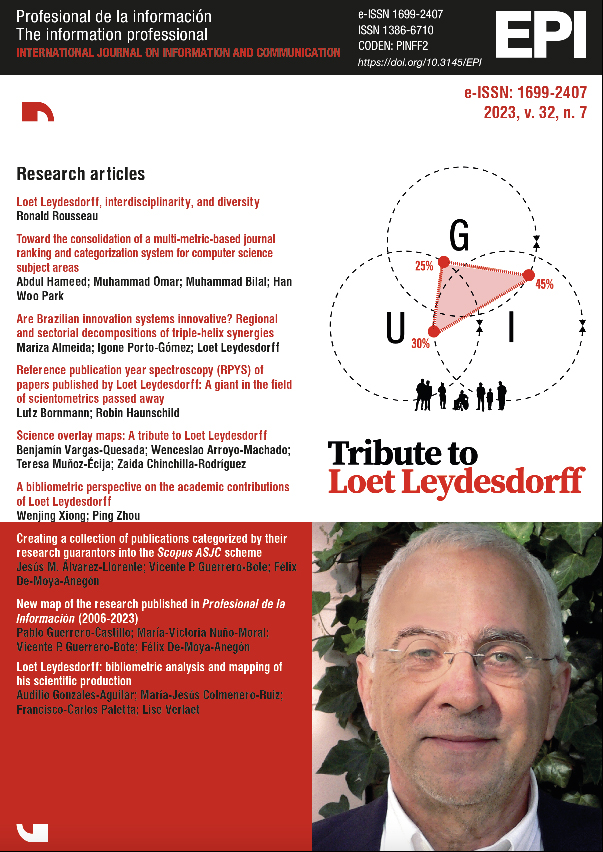New map of the research published in Profesional de la Información (2006-2023)
DOI:
https://doi.org/10.3145/epi.2023.dic.08Palabras clave:
Scientometrics, Co-word analysis, Knowledge maps, Thematic analysis, Scientific journals, Library & Information Science, Communication, Scopus, Profesional de la InformaciónResumen
In 2006, Profesional de la Información (EPI) began to be indexed by international scientific literature databases and is currently one of the leading Spanish journals in Library & Information Science and in Communication. Research fields can be characterized and analysed based on the patterns of keywords used in the publications. One of the most used techniques for this is co-word analysis. This technique is used in the present study to examine the structure of the research published in EPI. The journal’s two-fold spirit in Library & Information Science and in Communication is revealed, comprising six main thematic areas. Since no poor behaviour is seen in any of these areas, it can be concluded that, in becoming part of WoS and Scopus, EPI has entered a virtuous cycle that has led it to successfully expand its thematic scope, and to attain levels of impact and excellence superior to those of its origins.
Descargas
Citas
Blázquez-Ruiz, J.; Guerrero-Bote, V. P.; De-Moya-Anegón, F. (2016). “New Scientometric-Based Knowledge Map of Food Science Research (2003 to 2014)”. Comprehensive Reviews in Food Science and Food Safety, 15(6), 1040-1055. https://doi.org/10.1111/1541-4337.12223
Blázquez-Ruiz, J.; Guerrero-Bote, V. P.; De-Moya-Anegón, F. (2017). “Nuevo mapa conceptual de la investigación científica en ciencias de los alimentos basado en técnicas cienciométricas en España (2003-2014)”. Ibersid: revista de sistemas de información y documentación, 11(1), 13-31. https://doi.org/10.54886/ibersid.v11i1.4403
Bornmann, L. (2011). “Scientific peer review”. Annual Review of Information Science and Technology, 45(1), 197-245. https://doi.org/10.1002/aris.2011.1440450112
Bornmann, Lutz; De-Moya-Anegón, Félix; Leydesdorff, Loet (2012). “The new excellence indicator in the World Report of the SCImago Institutions Rankings 2011”. Journal of Informetrics, v. 6, n. 2, pp. 333-335. https://doi.org/10.1016/j.joi.2011.11.006
Callon, M.; Courtial, J.; Laville, F. (1991). “Co-word analysis as a tool for describing the network of interactions between basic and technological research: The case of polymer chemsitry”. Scientometrics, 22, 155-205. https://doi.org/10.1007/BF02019280
Callon, M.; Rip, A.; Law, J. (eds.). (1986). Mapping the dynamics of science and technology: Sociology of science in the real world. Springer. https://doi.org/10.1007/978-1-349-07408-2
Clauset, A.; Newman, M.; Moore, C. (2004). “Finding community structure in very large networks”. Physical Review E, 70(6). https://doi.org/10.1103/PhysRevE.70.066111
Hassan-Montero, Y.; De-Moya-Anegón, F.; Guerrero-Bote, V. P. (2022). “SCIMago Graphica: a new tool for exploring and visually communicating data”. Profesional de la Información, 31(5), e310502. https://doi.org/10.3145/epi.2022.sep.02
Herrera-Viedma, E.; López-Robles, J.-R.; Guallar, J.; Cobo, M.-J. (2020). “Global trends in coronavirus research at the time of Covid-19: A general bibliometric approach and content analysis using SciMAT”. Profesional de la Información, 29(3). https://doi.org/10.3145/epi.2020.may.22
Irvine, J.; Martin, B.; Peacock, T.; Turner, R. (1985). “Charting the decline of British science”. Nature, 316, 587-590. https://doi.org/10.1038/316587a0
Kleinberg, J. (2003). “Bursty and Hierarchical Structure in Streams”. Data Mining and Knowledge Discovery, 7(4), 373-397. https://doi.org/10.1023/A:1024940629314
Lechuga-Sancho, M.-P.; Martínez-Fierro, S.; Ramos-Rodríguez, A. R. (2023). “Thirty years of research on high-growth entrepreneurship: bibliometric overview of its H-Classics”. Profesional de la Información, 32(3). https://doi.org/10.3145/epi.2023.may.20
López-Robles, J. R.; Guallar, J.; Otegi-Olaso, J. R.; Gamboa-Rosales, N. K. (2019). “El Profesional de la Información (EPI): bibliometric and thematic analysis (2006-2017)”. El Profesional de la Información, v. 28, n. 4, e280417. https://doi.org/10.3145/epi.2019.jul.17
Noack, A. (2007). “Energy models for graph clustering”. Journal of Graph Algorithms and Applications, 11(2), 453-480. https://doi.org/10.7155/jgaa.00154
Noack, A. (2009). “Modularity clustering is force-directed layout”. Physical Review E, 79(2). https://doi.org/10.1103/PhysRevE.79.026102
Olmeda-Gómez, C.; Ovalle-Perandones, M. A.; Perianes-Rodríguez, A. (2017). “Co-word analysis and thematic landscapes in Spanish information science literature, 1985-2014”. Scientometrics, 113(1), 195-217. https://doi.org/10.1007/s11192-017-2486-8
Porter, M. F. (1980). “An algorithm for suffix stripping”. Program, 14(3), 130-137. https://doi.org/10.1108/eb046814
Rehn, Catharina; Kronman, Ulf (2008). Bibliometric handbook for Karolinska Institutet. Karolinska Institutet University Library. Version 1.05. https://doi.org/10.13140/RG.2.1.1480.9447
Romo-Fernández, L. M.; Guerrero-Bote, V. P.; Moya-Anegón, F. (2013). “Co-word based thematic analysis of renewable energy (1990-2010)”. Scientometrics, 97(3), 743-765. https://doi.org/10.1007/s11192-013-1009-5
Segado-Boj, F.; Gómez-García, S.; Díaz-Campo, J. (2022). “Intellectual and thematic structure of Communication research in Scopus (1980-2020). A comparative perspective among Spain, Europe, and Latin America”. Profesional de la Información, 31(1). https://doi.org/10.3145/epi.2022.ene.10
Velasco-López, J. E.; Carrasco, R.-A., Cobo, M. J.; Fernández-Avilés, G. (2023). “Data-driven scientific research based on public statistics: a bibliometric perspective”. Profesional de la Información, 32(3). https://doi.org/10.3145/epi.2023.may.14
Descargas
Publicado
Cómo citar
Número
Sección
Licencia
Derechos de autor 2023 Profesional de la información / Information Professional

Esta obra está bajo una licencia internacional Creative Commons Atribución 4.0.
Condiciones de difusión de los artículos una vez son publicados
Los autores pueden publicitar libremente sus artículos en webs, redes sociales y repositorios
Deberán respetarse sin embargo, las siguientes condiciones:
- Solo deberá hacerse pública la versión editorial. Rogamos que no se publiquen preprints, postprints o pruebas de imprenta.
- Junto con esa copia ha de incluirse una mención específica de la publicación en la que ha aparecido el texto, añadiendo además un enlace clicable a la URL: http://revista.profesionaldelainformacion.com
La revista Profesional de la información ofrece los artículos en acceso abierto con una licencia Creative Commons BY.




